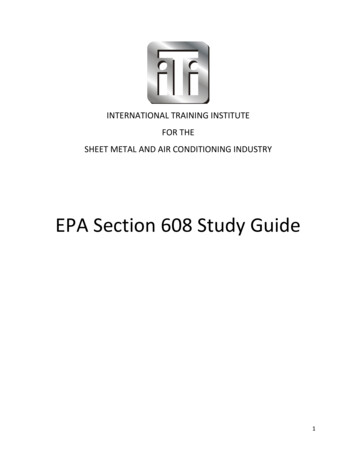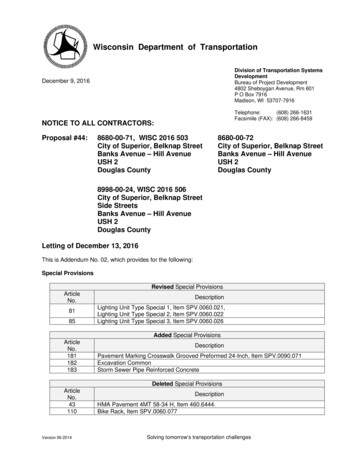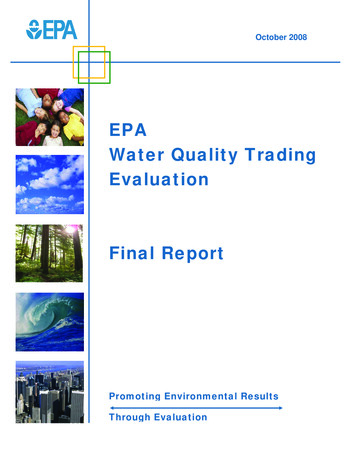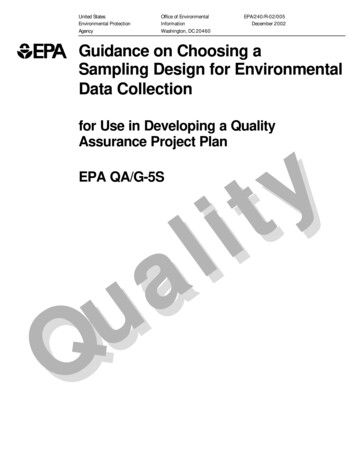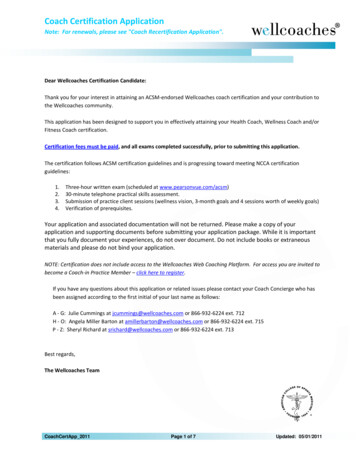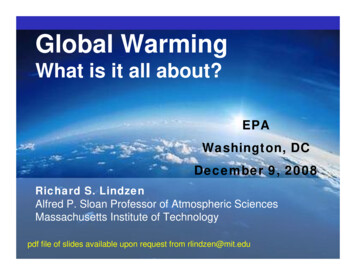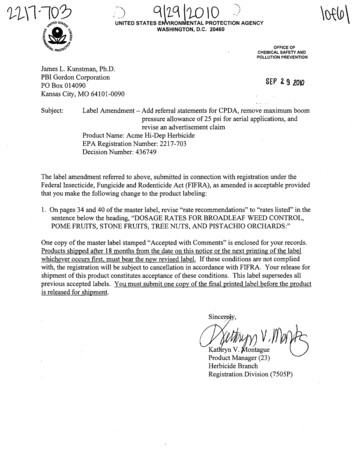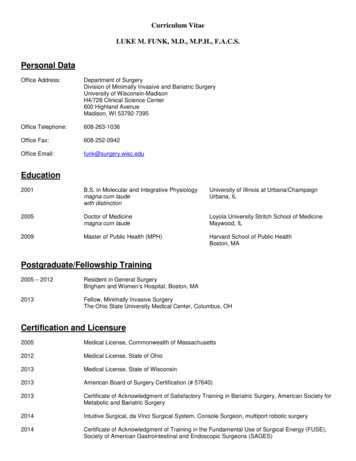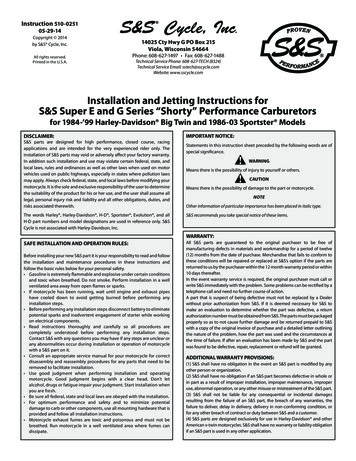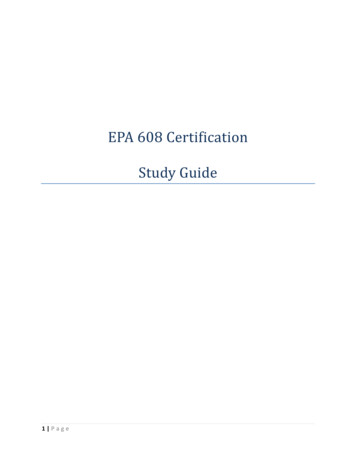
Transcription
EPA 608 CertificationStudy Guide1 Page
ForewordAll HVACR technicians must become certified for the equipment they work on, under the EnvironmentalProtection Agency’s (EPA), refrigerant recovery and recycling program.In order to become certified you must pass a test or series of tests, consisting of multiple choicequestions. The certifications and sections to the test are: Core Section. Information that applies to all certification types.Certification Class I. Small appliances under 5 pounds of refrigerant.Certification Class II. High Pressure. HVACR units over 5 pounds.Certification Class III. Low Pressure units including Centrifugal chillers.Certification Universal. All three, Type I, Type II, and Type III.Most residential and small commercial HVACR technicians need to be “Class II Certified” Everyone mustpass the core test (25 questions) and one to 3 of the other sections. If you take and pass all foursections you become universal certified.A 70% passing rate is required.The test questions are made available to testing organizations from the EPA bank of test questions.2 Page
ContentsContents . 3CORE SECTION, EPA Section 608 Refrigerant Recovery. 4TYPE 1 (Small Appliances) . 17TYPE II (High-Pressure) . 20TYPE 3 (Low-pressure) . 25EPA 608 Definitions . 31Core Test Sample Questions . 34Type I Sample Test Questions . 46Type II Sample Test Questions . 51Type III Sample Test Questions . 573 Page
CORE SECTION, EPA Section 608Refrigerant RecoveryThis study guide follows the outline from the EPA describing the subject material to be used forcertification exam questions. The titles displayed as . Descriptions displayed in italics are fromthe EPA that outlines subjects to be covered are from the EPA.The other text following the highlighted text provides further explanation.The CORE section is required for all certifications. This section covers the environmental impactof refrigerants, CFC’s and HCFC’s, the Clean Air Act and EPA regulations. Destruction of ozone by chlorine.Ozone DepletionChlorine reacts with Ozone and creates “Chlorine Monoxide”. Chlorine Monoxide doesn’t lastlong and the molecules soon return to the original chlorine state. This reaction continues withone chlorine destroying thousands of Ozone molecules.The primary objective of EPA Section 608, is to prevent further “Depletion of the Ozone layer”in the earth’s stratosphere. Most of the Ozone is in the layer of the atmosphere called thestratosphere. The Troposphere is the first layer extending from the ground to 6-7 miles abovethe surface. The stratosphere is located from 6-7 miles up, to 30 miles above the earth’ssurface. Presence of chlorine in CFC and HCFC refrigerants.Refrigerants, CFC and HCFC, containing Chlorine are the source of the Ozone depletionproblem. The refrigerants are harmless in the lower layer of the atmosphere, but theyeventually drift up into the stratosphere. The increased UV in the stratosphere breaks the CFCand HCFV down releasing the Chlorine contained in the refrigerants.4 Page
. Identification of CFC, HCFC, and HFC refrigerants (not chemical formulas, but idea that R-12 isa CFC, R-22 is an HCFC, R-134 is an HFC, etc.).REFRIGERANTSCFC chlorofluorocarbonC CHLORO (Chlorine)F FLUORO (Fluorine)C CarbonCommon CFC refrigerants include R-11, R-12, R-113, R-114, R-115, R-500 and R-502HCFC hydrochlorofluorocarbonH Hydro (Hydrogen)C Chloro (Chlorine)F Fluoro (Fluorine)C CarbonCommon HCFC refrigerants include R-22, 123 and 124HFC hydrofluorocarbonH Hydro (Hydrogen)F Fluoro (Fluorine)C CarbonCommon HFC refrigerants include R-134A. Idea that CFCs have higher ozone-depletion potential (ODP) than HCFCs, which in turn havehigher ODP than HFCs.Ranking Refrigerants for Potential DamageSome refrigerants pose a danger to “Ozone depletion”. Ozone depletion lets too much UV in.Some refrigerants pose a danger to “Global Warming”. Greenhouse gases trap the heatcontributing to global warming and climate change.CFC and HVFC are bad for Ozone depletion and HFC is not.Ozone can be bad or good depending on where it is located in the atmosphere. Good ozone isin the Stratosphere where it acts as a UV filter. If ozone is in the Troposphere, the air layerclosest to the surface, it is considered a pollutant (smog) and is bad.5 Page
Ozone is a molecule consisting of 3 oxygen atoms bonded together. Chemicals used asrefrigerants in HVACR (heating, ventilation, air conditioning, refrigeration) deplete Ozone, andhave created a hole in the ozone layer of the atmosphere. Ozone in the atmospheric layerbelow the stratosphere, called the troposphere, is a pollutant and causes a greenhouse gaseffect contributing to global warming. Health and environmental effects of ozone depletion.Stratospheric Ozone creates a protective layer that filters out ultraviolet (UV) sunlight fromreaching the earth’s surface. Too much UV causes weakening of the immune system, increasesskin cancer and eye cataracts.The greenhouse gas effect traps heat close to the earth contributing to global warming. Evidence of ozone depletion and role of CFCs and HCFCs.Since Chlorine Monoxide has a short life, its existence in the stratosphere is the proof that theproblem of Ozone Depletion is manmade chlorine. In contrast, naturally occurring chlorine,dissolves in water and is washed away by rain before it can reach the stratosphere. TheChlorine in the CFC molecule does not dissolve in water and the chlorine is not released until itreaches the stratosphere.Another chemical contained in CFC refrigerants is fluorine. Fluorine does not occur naturallywith chlorine. The presence of Fluorine in the Stratosphere is further evidence that the sourceof the Ozone depletion problems is manmade refrigerants. CFC Phase-out Date.In 1990 the US Congress amended the “Clean Air Act” and assigned the EPA (EnvironmentalProtection Agency) the responsibility of reducing Ozone depletion by managing air quality andatmospheric protection by giving the EPA regulatory powers.CFC can no longer be manufactured or imported into the USA effective January 1, 1996.However, refrigerant manufactured before this date or refrigerant recovered andrecycled can be used. Venting prohibition at servicing.Knowingly venting regulated refrigerants is prohibited except for the following:Release of minimal amounts (de minimus, meaning not very much or minimal) of refrigerantwhile attempting to recapture, recycle or dispose of refrigerant.6 Page
Release of refrigerant during normal operation of air conditioning and refrigerationequipment as opposed to release during service, maintenance or repair is allowed. Anexample is mechanical purging from a purge unit on a low pressure chiller.Leaks more than specified size must be repaired: Commercial refrigeration or industrial process refrigeration. Amount of charge ismore than 50 pounds and leaking 35% annually must be repaired. All other leaking 15% annually must be repaired. Systems containing less than 50 pounds not specified. CFC or HCFC not used as refrigerant may be released. An example is R-22 mixedwith nitrogen and used as a holding charge. You may not however add nitrogen torefrigerant to use this allowance. You may release small amounts of refrigerant to purge hoses used with manifoldgauges. Recovery and recycling equipment manufactured after November 15, 1993must have low-loss fittings. Venting prohibition at disposal.When disposing of appliances and units containing CFC and HCFC refrigerants, the refrigerantmust be recovered from all appliances at the same rate used for servicing the units.Responsibility for disposal falls to the last person involved in the disposal. This is usually themetal recycler. This person must maintain records including statements that the refrigerant hasbeen removed. Venting prohibition on substitute refrigerants in November, 1995.Venting substitutes for CFC and HCFC became illegal after November 1995. HFC’s wereincluded, not because of Ozone depletion, but because of global warming potential. Maximum penalty under CAA.Violating the Clean Air Act (CAA) can result in a fine to the employee and employer of up to 27,500.00 per day per violation. Reporting a violation resulting in a fine can earn a reward ofup to 10,000.00. Montreal Protocol (international agreement to phase out production of ozone-depletingsubstances).In 1987 an international conference held in Montreal that resulted in a treaty called the“Montreal Protocol”. The result was a treaty eas to eliminate Ozone depletion chemicalsincluding CFC, HCFC and Halon. Halon is a chemical used in fire extinguishing.7 Page
Section 608 Regulations. Definition/identification of high and low-pressure refrigerants.High pressure refrigerant has a boiling point between -50C and 10C degrees or -58F and 50Fdegrees at atmospheric pressure (29.9 inches of mercury). Included refrigerants are 12, 22,114, 500 and 502Very high pressure refrigerant has a boiling point below -50C or -58F at atmospheric pressure.Included refrigerants are 13 and 503.Low pressure refrigerant has a boiling point above 10C or 50F at atmospheric pressure.Refrigerants included are 11, 113, and 123. Definition of system-dependent vs. self-contained recovery/recycling equipment.System dependant recovery (passive recovery) requires the assistance of components (such asthe appliance or unit’s compressor) contained in the appliance (unit) to remove the refrigerantfrom the appliance (unit).Self contained recovery (active recovery) equipment has its own compressor/pump. Identification of equipment covered by the rule (all air-conditioning and refrigerationequipment containing CFCs or HCFCs except motor vehicle air conditioners).As of July 13, 1993, all systems in general that are to be opened to the atmosphere for anyreason, including disposal, must have the refrigerant recovered and must be evacuated to thelevels specified. Need for third-party certification of recycling and recovery equipment manufactured afterNovember 15, 1993.Recovery equipment manufactured or imported after November 15, 1993 must be testedand certified by an EPA approved Laboratory or organization. Standard for reclaimed refrigerant (ARI 700).The purpose of this standard is to establish purity specifications, to verify composition, and tospecify the associated methods of testing for acceptability of fluorocarbon refrigerantsregardless of source (new, reclaimed and/or repackaged) for use in new and existingrefrigeration and air-conditioning products within the scope of ARI.8 Page
. Absence of "drop-in" replacements.Substitute Refrigerants and OilsDue to incompatibility of substitute refrigerants with many lubricants used with CFC and HCFCrefrigerants and incompatibility of CFC and HCFC refrigerants with many new lubricants, drop-inreplacements are not available. (includes identification of lubricants for given refrigerants, suchas esters with 134; alkylbenzenes for HCFCs) .Refrigeration OilsThe purpose of refrigeration oil is to lubricate the compressor. The oil and refrigerant arepresent in the same sealed system. If the oil does not mix well with the refrigerant (miscible),the oil would be carried into the system and become separated and trapped.Water is the enemy of oil. Pressure, heat and water in oil will produce acids and causeproblems with the insulation on motor windings and corrosion of metal parts. Oil that absorbsmoisture is called hygroscopic. Filter dryers are used to keep the refrigerant and oil dry.Many compressors are equipped with a crankcase heater to keep the refrigerant frommigrating to the compressor. Refrigerant can condense in the oil and boil off when thecompressor starts causing compressor damage.CFC and HCFC use the older mineral oil and alkylbenzenes. New refrigerants have required thedevelopment of new refrigerant oils including POE (polyol esters) and PAG (polyalkylene glycol. Fractionation problem--tendency of different components of blends to leak at differentrates.Refrigerant BlendsRefrigerants numbered 4xx are zeotropic meaning each refrigerant in the blend keeps itsown temperature/pressure characteristics. These refrigerants have “temperatureglide”, meaning the higher pressure refrigerant will vaporize first and condense lastfollowed by the lower pressure refrigerant. A blend of three refrigerants is called aternary blend.The component refrigerants in zeotropic blends can leak at different rates since theyvaporize at different times. This characteristic, called fractionation can cause a changein the blend and a change in how the refrigerant performs. These refrigerants should beintroduced into the system (charged) as a liquid and not a gas, so they keep theircharacteristics.9 Page
Refrigerants with a 5xx numbering are azeotropic meaning they will act like a singlerefrigerant in regard to pressure/temperature.Refrigeration. Refrigerant states (vapor vs. liquid) and pressures at different points of refrigeration cycle;how/when cooling occurs.(See reference book on the basics of the refrigeration cycle and become knowledgeable in thisprocess). Refrigeration gauges (color codes, ranges of different types, proper use).The gauge manifold set (also known as a service manifold) is an important tool for theTechnician that measures pressure readings at different points in the refrigeration system. TheCompound gauge is usually blue and measures low pressure (psig) and vacuum (inches Hg).The High pressure gauge is usually red and measures the high side (discharge) pressure. Thescale on the high pressure side is a continuous scale and is usually calibrated to read from 0 to500 psi.The center port of the manifold is usually a yellow hose and can be connected to a recoverydevice, evacuation vacuum pump or charging device.Leak DetectionReducing intentional release of CFC and HCFC refrigerants is one of the primary goals of thisrule as is preventing and eliminating accidental leaks.Pressure testing new or repaired systems with nitrogen before charging with refrigerant is agood practice. If the system does not hold pressure a leak must be located andrepaired. If the leak cannot be found using an inert gas and pressure test, the EPAallows, as a last resort, using some refrigerant as a trace gas and a refrigerant sensingtool to find the leak.The system should be evacuated and hold a vacuum prior to charging with refrigerant.Leaks are indicated by: 10 P a g eLow refrigerant chargeHigh superheatTraces of oil on a tube or fitting jointWorn tubing due to vibrationAccess points such as Schrader valves and service valves
Shaft seals on open compressorsTools used to locate leaks Electronic IR leak detectorsElectronic ultrasound leak detectorsBrushing bubble producing soap liquid on potential leak areasHalide torch flame turns green indicating refrigerantAdding dye to the systemLeak Repair Requirements It is good practice to find and repair leaks.EPA does not require repair of leaks holding less than 50 pounds of refrigerantEPA does require repair of leaks in systems containing 50 pounds or more of refrigerantwhen:Commercial and industrial process refrigeration systems when the leak exceeds35% of the charge per year.Equipment other than commercial and industrial process refrigeration when theleak exceeds 15% of the charge per year.Leaks requiring repair must be repaired within 30 days of discovery. Exception, when theowner of the equipment develops a plan to retrofit or retire the equipment within one year.Documentation of the plan must be kept on site and work completed within one year.Three R's. Definitions. Recover.To remove refrigerant in any condition from a system in either an active or passive manner, andstore it in an external container without testing or processing.RecoveryRegulated refrigerants, HFC, HCFC, must be recovered prior to opening a system. Nonregulated refrigerants do not have to be recovered.All other non-MVAC (motorized Vehicle AC) Appliances. You must have an active recoverydevise available unless you are only working on small appliances. An active recovery device hasits own compressor, pump or device to remove refrigerant.11 P a g e
Recovery Evacuation Rules Appliance, HCFC 22 w/ less than 200 pounds, (0) Inches of Hg VacuumAppliance/Unit, HCFC 22 w/ more than 200 pounds (4 or 10*) Inches Hg vacuumAppliance/Unit, CFC 12, 500, 502, 114 less than 200 pounds (4 or 10*) Inches HgvacuumAppliance/Unit, CFC 12, 500, 502, 114 more than 200 pounds (4 or 15*)Very high-pressure appliance CFC 13, 503 (0) Inches Hg VacuumLow-pressure appliance CFC 11, 123 (25 or 25 mm Hg absolute*)*On or after November 15, 1993, recovery equipment certified by EPA approved testingorganization.You are not required to recover refrigerant if the leak is too large and will draw air into thesystem. Recycle.To reduce contaminants in the used refrigerant by: Oil separationNon-condensable removalSingle or multiple passes through devices that reduce moisture, acidity, and particulatematter, such as replaceable core filter dryers. Reclaim.To process the used refrigerant to new product specifications by means which may includedistillation.Chemical analysis of the refrigerant is required to assure that appropriate productspecifications are met.Need to avoid mixing refrigerants.Never mix refrigerants in recovery containers.12 P a g e
. Factors affecting speed of recovery (ambient temperature, size of recycling or recoveryequipment, hose length and diameter, etc.).Recovery TechniquesYou can speed up recovery using these techniques: Keep the system pressure high to move refrigerant to the lower pressure recoverydevice faster.Keep the recovery container pressure as low as possible to draw out the refrigerant.High outside ambient temperature will produce a higher system pressure.Heating the system components with heaters will increase system pressures.Place the recovery container in ice to lower its pressure.Use short large diameter hoses to reduce pressure drop.Properly maintain your recovery equipmentDehydration Evacuation. Need to evacuate system to eliminate air and moisture at the end of service.Evacuation and DehydrationUsing a vacuum pump and lowering the pressure in the system causes any moisture tovaporize. The pump can then remove the vapor. Air, moisture and non condensable gas areharmful to HVACR systems, their capacity and efficiency. Any system or tubing that has beenexposed to the atmosphere should be evacuated before charging with refrigerant.Lowering the system pressure rapidly can freeze water in the system. Caution should beexercised if there is potential for excessive water. Take longer to pull the vacuum, introducenitrogen or provide heat.A micron gage should be used to determine effectiveness of your evacuation. The systemshould pull down to 500 microns. After the 500 micron level is obtained the pump should bevalved off from the system while you observe if the vacuum holds. The following will result inan observable loss of vacuum. 13 P a g eThe system contains liquid refrigerant that continues to vaporizeWater in the system continues to vaporizeThere is a leakLoose connections
Evacuation Level Requirements for Appliances (effective July 13, 1993) Appliance, HCFC 22 w/ less than 200 pounds, (0) Inches of Hg VacuumAppliance, HCFC 22 w/ more than 200 pounds (4 or 10*) Inches Hg vacuumAppliance, CFC 12, 500, 502, 114 less than 200 pounds (4 or 10*) Inches Hg vacuumAppliance, CFC 12, 500, 502, 114 more than 200 pounds (4 or 15*)Very high-pressure appliance CFC 13, 503 (0) Inches Hg VacuumLow-pressure appliance CFC 11, 123 (25 or 25 mm Hg absolute*)*On or after November 15, 1993, recovery equipment certified by EPA approved testingorganizationEvacuation Level ExceptionsIf a system has a leak large enough to prevent evacuation to the prescribed level, the systemmust be evacuated to atmospheric pressure (0 psig) before being opened.Safety. Risks of exposure to refrigerant (e.g., oxygen deprivation, cardiac effects, frost bite, long-termhazards).Use good judgment and remember gas under high pressure can be dangerous Escaping gas can cause skin and eye damage.Escaping gas can stir up dust and debris that can be hazardous.Wear goggles when handling pressurized gases.All systems should have a high pressure relief valve.Nitrogen cylinders are under about 2000 psi. Always use a pressure regulator withnitrogen. System components such as coils can be damaged. Make sure a pressurerelief valve is installed in case the pressure regulator fails. Don’t install pressurerelief valves in series.Never use compressed air or oxygen in a system. Air containing compressed oxygenin the presence of oil, is highly explosive. Personal protective equipment (gloves, goggles, self-contained breathing apparatus--SCBA--inextreme cases, etc). 14 P a g eRefrigerants at atmospheric pressure produce extremely cold temperatures and cancause frostbite. Wear safety glasses, goggles, rubber lined gloves, long sleeve shirtsand long pants.
Refrigerants are heavier than air. If you are in a confined space the refrigerant candisplace the oxygen resulting is suffocation. In areas where large amounts ofrefrigerant exist, safety gear such as self contained breathing apparatus (SCBA)should be available. Evacuate the area until it can be ventilated.Some refrigerants are toxic. Others are considered non-toxic but are still dangerousin higher concentrations. Safe limits are measured in parts per million (ppm).Another common measure is the “Threshold Limit Value – Time Weighted Average”(TLV-TWA) Safety standard are developed for protection above these limits.o ASHRAE Standard 34. This standard classifies refrigerants into groups accordingto flammability and toxicity. Low toxicity refrigerants are class A, high toxicityare class B. Non-flammability refrigerants are class 1 and higher flammablerefrigerants are class 3. (A1, A2, A3, B1, B2, B3)Chemical changes from heat. Flames or high heat from soldering or welding can produce acidsor poisonous gases from refrigerants. Hydrochloric acid, hydrofluoric acid and phosgene gascan be deadly. Remove refrigerant and evacuate any components before soldering or welding. Reusable (or "recovery") cylinders vs. disposable cylinders (ensure former DOT approved,know former's yellow and gray color code, never refill latter).Refrigerant CylindersRefrigerant cylinders are color coded according to the type of refrigerant contained in thecylinder and the use of the cylinder. Storage cylinders. Larger cylinders used for storing refrigerant to be transferred tosmaller refillable cylinders.Reusable cylinders (refillable) Gray with a yellow top. These cylinders are used forrecovery or transporting refrigerant.Disposable cylinders. Single use cylinders. It is a violation to refill disposable cylinders.These cylinders are designated as DOT Specification 39, non-reusable cylinders. Emptycylinders should have the pressure reduced to zero and the cylinder rendered unusable. Risks of filling cylinders more than 80 percent full.Use good judgment and remember gas under high pressure can be dangerous. Never fill acontainer more than 80% to allow for expanding gas.15 P a g e
. Use of nitrogen rather than oxygen or compressed air for leak detection.Never use compressed air or oxygen in a system. Air containing oxygen when compressedis highly explosive. Use of pressure regulator and relief valve with nitrogen.Nitrogen cylinders are under high pressure, about 2000 psi. Always use a pressure regulatorwith nitrogen. System components such as coils can be damaged. Make sure a pressure reliefvalve is installed in case the pressure regulator fails. Don’t install pressure relief valves inseries.Shipping. Labels required for refrigerant cylinders (refrigerant identification, DOT classification tag).DOT (Department of Transportation) requires proper DOT tags be attached to cylindersincluding the refrigerant type contained in the cylinder. DOT requires all cylinders behydrostatically tested and stamped every five years.Disposable cylinders are designated as DOT Specification 39, non-reusable cylinders.16 P a g e
TYPE 1 (Small Appliances)Recovery Requirements. Definition of "small appliance”.Any of the following products that are fully manufactured, charged, and hermetically sealed in a factorywith five pounds or less of refrigerant: refrigerators and freezers designed for home use, room airconditioners (including window air conditioners and packaged terminal air conditioners), packagedterminal heat pumps, dehumidifiers, under-the-counter ice makers, vending machines, and drinkingwater coolers. Evacuation requirements for small appliances with and without working compressors usingrecovery equipment manufactured before November 15, 1993.Evacuation Level Requirements for Small Appliances (effective July 13, 1993)Appliance with a charge under 5 poundsUsing a recovery device manufactured before November 15, 1993 Compressor running or not, 80% of charge or 4 Inches Hg vacuumCompressor running 90% or 4 Inches Hg vacuum. Evacuation requirements for small appliances with and without working compressors usingrecovery equipment manufactured after November 15, 1993.Using a recovery device manufactured on or after November 15, 1993Evacuation of Small Appliances. If you only work on small appliances you can use a passiverecovery device. A passive recovery device can utilize the compressor or pressure in theappliance you are working on to move the refrigerant to an external container.Before November 15, 1993 80% of the charge must be removed or 4 inches Hg of vacuum.On or after November 15, 1993 Remove 80% if the appliance is not running and 90% if running or 4 inches Hgvacuum.17 P a g e
Recovery Techniques. Use of pressure and temperature to identify refrigerants and detect noncondensables.Once you have recovered the refrigerant and it is at room temperature, use apressure/temperature chart to verify that the pressures in the cylinder match the pressures onthe chart. Pressures and temperatures that do not match indicate the presence of air or othernoncondensables. Methods to recover refrigerant from small appliances with inoperative compressors using asystem-dependent or "passive") recovery device (e.g., heat and sharply strike the compressor,use a vacuum pump with non-pressurized recovery container).You can recover refrigerant on small appliances using a passive recovery device. This can be anevacuated refrigerant cylinder or an atmospheric bag. Any appliance with 15 pounds or lessrefrigerant can use a passive recovery device.Methods to assist passive recovery: Use the appliance compressor to pump refrigerant.Use the pressure of the refrigerant to facilitate transfer.Heat the compressor and strike the compressor to cause the oil to give up refrigerant. Need to install both high and low side access valves when recovering refrigerant from smallappliances with inoperative compressors.If the compressor on the appliance is not operable you will recover refrigerant from high sideand low side access valves in order to recover the required 80% of the refrigerant at 4 inches Hgvacuum. Need to operate operative compressors when recovering refrigerant with a system-dependent("passive") recovery device.If the compressor is capable of running, you should use it to pump refrigerant into the nonpressurized compressor from a single access valve on the high side. Should remove solderless access fittings at conclusion of service.?Solderless fittings can leak over time and should be removed.18 P a g e
. 134a as likely substitute for R-12. Decomposition products of refrigerants at high temperatures (HCl, HFl etc) .Chemical changes from heat. Flames or high heat from soldering can produce acids orpoisonous gases from refrigerants. Hydrochloric acid, hydrofluoric acid and phosgene gas canbe deadly. Remove refrigerant and evacuate any components before soldering or welding.This compound can be decomposed by high temperatures (open flames, glowing metal surfaces, etc.)forming hydrochloric and hydrofluoric acids and possible carbonyl halides.SafetyRefrigerants at atmospheric pressure produce extremely cold temperatures and can causefrostbite. Wear safety glasses, goggles, rubber lined gloves, long sleeve shirts and longpants.Refrigerants are heavier than air. If you are in a confined space the refrigerant can displacethe oxygen resulting is suffocation. In areas where large amounts of refrigerant exist,safety gear such as self contained breathing appara
This study guide follows the outline from the EPA describing the subject material to be used for certification exam questions. The titles displayed as . Descriptions displayed in italics are from the EPA that outlines subjects to be covered are from the EPA. The other text following the highlighted text provides further explanation.
